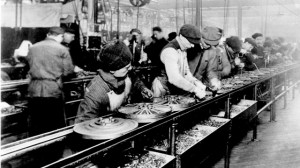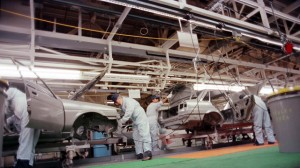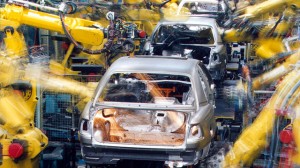This post first appeared in The American Prospect.

Workers are photographed on a flywheel assembly line at the Ford Motor Company's Highland Park, Mi., plant in 1913. The use of a moving line reduced a car's assembly time from 12 hours to 93 minutes. (AP Photo/Ford Motor Company)
The day I visited, a clump of men and women toiled away near a series of conveyor belts, filling small specialty orders. But machines — not human beings — were handling the bulk of the chores. “As you can see, there are no more people doing the retrieving,” Iddo Benzeevi, the chief executive of Highland Fairview, the firm that developed the site, told me. “It’s the computer doing it all by itself.”
A driverless crane swung into motion nearby, delivering a box of shoes to its appointed spot in the stacks. A moment later, guided by a web of sensors and software, the mammoth contraption plucked another box and shuttled it in a different direction. Then it zipped back, red lights flashing. In this immense section of the facility, nobody lays a finger on any of the goods, all stamped “Made in China.”
About 700 people work in the Skechers warehouse, according to Benzeevi, and as many as 300 more could be added in the next few years as business expands. That, however, is about 30 percent fewer jobs than one would expect at a more traditional logistics operation of the same size. A local newspaper, The Press-Enterprise, reported last year that because Skechers transferred work to Moreno Valley from a handful of less-automated warehouses, it has meant a net loss of as many as 400 jobs across the area. (Skechers officials declined to comment.)
Benzeevi is unapologetic about any such casualties and points to a growing logistics industry, the fierce nature of global competition, the unrelenting march of technology, and the quality of jobs that are found at his cutting-edge distribution center — relatively high-skilled, high-paying ones (such as programming computers and repairing sophisticated pieces of equipment) versus the more menial variety that have been wiped out (like hauling around pallets with a forklift). “They are better jobs, which is where America should be,” he says.
Fears that automation will eat employment are hardly new. A decade or so after the end of World War II, concerns about what some were calling the “Second Industrial Revolution” mounted.
“With automatic machines taking over so many jobs,” the wife of an unemployed textile worker in Roanoke, Virginia, told a reporter in 1959, “it looks like the men may have finally outsmarted themselves.” James Carey, president of the International Union of Electrical, Radio, and Machine Workers, was blunter. “Automation could displace most workers,” he warned.
Corporate executives of the era largely dismissed these worries, maintaining that for every worker cast aside by a machine, even more jobs were being generated. “Technological progress sets off a sort of chain reaction of economic growth,” Ralph Cordiner, the president of General Electric, assured Congress in 1955.
Sometimes, new enterprises sprang to life. “The automatic-control industry is young and incredibly vigorous,” John Diebold, dubbed “the prophet of information technology,” told a gathering of business leaders in 1954.
Mostly, job gains were realized at the very same companies where new technology was being deployed, as huge increases in output led to the need for more workers overall — office personnel, engineers, maintenance staff, factory hands — to keep up with rising consumer demand. Labor historian Nelson Lichtenstein has pointed out that payrolls in the U.S. automobile industry swelled by about 15 percent through the 1950s and 1960s even as technology spread and factory productivity more than doubled.
More broadly, a 1963 study by University of Chicago economist Yale Brozen found that while 13 million jobs had been destroyed during the 1950s, the adoption of new technology was among the key ingredients that led to the creation of more than 20 million jobs. “Instead of being alarmed about growing automation, we ought to be cheering it on,” he wrote. “The catastrophe that doom criers constantly threaten us with has retreated into such a dim future that we simply cannot take their pronouncements seriously.”
Brozen was too dismissive. Technological upheaval caused both the steel and rail industries, for instance, to suffer drops in employment in the late 1950s. “In converting to more automated processes, many industries found it less costly to build a new plant in another area rather than converting their older factories, thus leaving whole communities of employees stranded,” the Department of Labor noted in one study of the period.
In the end, the first big wave of postwar technological change was far from benign. But, on balance, it didn’t destroy nearly as many jobs as some had predicted. Even labor leaders acknowledged it was inevitable that machines would play an ever larger role in the lives of workers and that the trend could bring plenty of benefits if managed right. “You can’t stop technological progress, and it would be silly to try it if you could,” said Walter Reuther, president of the United Automobile Workers. The best that unions and their allies could hope for was to temper automation’s ill effects.
Reuther, for one, responded to advancing technology in various ways, including pushing for a guaranteed annual wage from the car companies — a cash balm for any workers idled by automation. But the surest means of keeping machines from biting too hard was to teach as many people as possible to use them.

The assembly line at the New United Motor Manufacturing Inc., plant in Fremont, Calif., in 1985. (AP Photo/Paul Sakuma, File)
Today, U.S. companies continue to invest heavily in training, pouring more than $60 billion a year into such initiatives. But unlike in the past, businesses say they can no longer rely on their workers’ obtaining the skills they need from another crucial source: the public classroom.
For a long time, “because the American people were the most educated in the world, they were in the best position to invent, be entrepreneurial, and produce goods and services using advanced technologies,” Harvard professors Claudia Goldin and Lawrence Katz assert in their 2008 book, The Race Between Education and Technology. For those born from the 1870s until about 1950, the authors found, every decade witnessed an uptick of about 0.8 years of education. In other words, “during that 80-year period the vast majority of parents had children whose educational attainment greatly exceeded theirs.” But then something happened: “Educational change between the generations … came to an abrupt standstill.”
The timing couldn’t have been worse. To perform practically any function in the Skechers warehouse, “you need to use a computer,” Benzeevi says. “It takes new skills.” Yet relatively few people have them. Even fewer are prepared for the kinds of jobs that may come next.
In the future, “it is a safe bet that the human labor market will center on three kinds of work,” Massachusetts Institute of Technology’s Frank Levy and Harvard’s Richard Murnane write in “Dancing with Robots,” a report issued in June by the Washington-based think tank Third Way. The first is solving unstructured problems. The second is acquiring, making sense of, and communicating new information. Computers aren’t good at either of these tasks. The third is non-routine manual labor (like schlepping furniture), which also can’t be tackled by a computer.
The first two will undoubtedly pay well. The third will not. “In this context,” Levy and Murnane conclude, “the nation’s challenge is to sharply increase the fraction of American children with the foundational skills needed to develop job-relevant knowledge and to learn efficiently over a lifetime.” As daunting as all of this is, it isn’t what concerns some the most.

An automated production line with robots at the Opel factory in Ruesselheim is shown on this undated handout photo. (AP Photo/Opel, HO)
Most economists dismiss (or at least heavily discount) the idea. Follow the historic pattern, they argue. Innovative and entrepreneurial, the United States has always found a way to make lots of jobs out of the next new thing. It can be difficult getting from here to there — “very, very disruptive and very, very hard” for masses of people caught in the transition, as James Cash, a Harvard business professor, puts it. But we’ve always produced enough jobs while absorbing the mechanical cotton picker, the mainframe, the microprocessor, the robot, and so much more. “Over the long term, employment rates are fairly stable,” Lawrence Katz told the MIT Technology Review earlier this year. “People have always been able to create new jobs.”
John Husing, an economist in the Inland Empire, the region east of Los Angeles where the Skechers facility is located, agrees. Even though he was the one who told me about the warehouse, marveling at the way “nobody touches a box, nobody touches a shoe,” he believes that we’re in the midst of a classic structural shift in the economy. “Do I think there will be enough jobs?” he asks. “Yes, I do.” Then he adds: “How are you going to distribute the shoes? Somebody has to drive the trucks.”
Well, maybe not for long. Over the summer, The Wall Street Journal reported on a growing phenomenon: autonomous trucks. A fleet of these driverless rigs requires “no workers’ compensation, no payroll tax, no health-care benefits,” James Barrett, the president of a transport company in Scranton, Pennsylvania, told the Journal. “You keep going down the checklist, and it becomes pretty cheap.”
The example is telling. In an article in the MIT Sloan Management Review last year, professor Erik Brynjolfsson and research scientist Andrew McAfee pointed out that less than a decade ago, truck driving was viewed as an occupation that would be difficult, if not impossible, to automate. But in 2010, Google announced that its driverless cars were hitting the road, and now Caterpillar is rolling out driverless trucks at an Australian mine. In short order, “real-world driving went from being an example of a task that couldn’t be automated to an example of one that was,” Brynjolfsson and McAfee wrote.
The duo, who co-authored the 2011 book Race Against the Machine, are convinced that, as Brynjolfsson has described it, “we’re having the automation and the job destruction,” but “we’re not having the creation at the same pace” anymore. Life will change for the better in many ways because of these breakthroughs. Consumers will delight in a wealth of new products, services, and experiences. But, say Brynjolfsson and McAfee, we “also need to start preparing for a technology-fueled economy that’s ever more productive but that just might not need a great deal of human labor.”
What that portends for our social fabric, one can only imagine. When the UAW’s Walter Reuther visited a state-of-the-art Ford plant in Cleveland in 1954, the executive showing him around pointed to a series of automated loading machines. “How are you going to collect union dues from these guys?” the executive asked. Replied Reuther: “How are you going to get them to buy Fords?”

